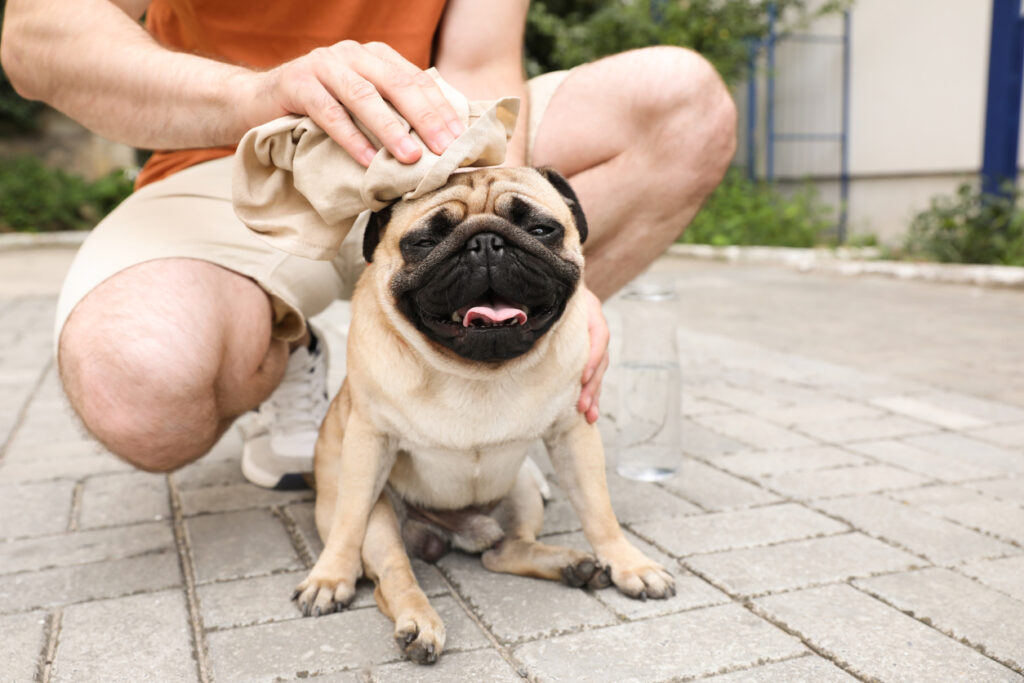Signs of a Dog Overheating and How to Help
Dogs are active creatures that exert a lot of energy while they are moving. During warmer weather, this exertion can often lead to their body overheating which can be dangerous if left untreated. Things like seizures and cardiac arrest can happen quickly if an overheated dog is left without care. The good news is that there are things you can do to help and signs to look for when overheating begins.
Being prepared for a potential overheating episode with your dog is an important part of being a responsible pet owner. Knowing what to do to help keep them safe is imperative. When you are out and about in warmer weather, it is helpful to always be prepared with cold water and rags in case overheating occurs. Knowing the signs for when a dog is overheating and knowing how to help will protect your dog from getting sick from the heat.
Physical Signs of Overheating in Dogs
When a dog begins to get too hot, there are some early warning signs to look out for before it becomes worrisome. There are also differences between mild heat exhaustion and a more extreme version called hyperthermia. If your dog is experiencing hyperthermia, that means their internal temperature has reached an unhealthy range and they need to be seen by a veterinarian immediately.
One of the most obvious signs of an overheated dog is panting and heavy breathing. A panting dog often means they are dehydrated and in need of water. On hot days, experts advise encouraging your dog to drink water every hour. If your dog is panting heavily this isn’t an emergency yet, but getting them water is important to help prevent things from getting worse.
Checking their tongue or gums is one of the ways many veterinarians suggest seeing how dehydrated your dog has become. If their gums or tongue are a bright red color or a dark red color, it’s time to get them help.
If your dog seems disoriented or lethargic, this can also be a sign of overheating. An unconscious dog is an immediate emergency, and a dog should be seen right away. Any signs of an upset stomach such as vomiting or diarrhea are also signs of a dog’s internal temperature being above a safe temperature.
How to Help Your Overheated Dog
Panting and lethargic dogs can make an owner panic and want to help them right away. While they do need help, it is important to give them the right kind of help. Many people think that getting their dog as cold as possible after overheating is the best thing to do. However, this can actually cause more harm than good since extreme changes in temperature can put a dog’s body under intense stress.
The best thing to do when your dog is overheated is to find a cooler place for them to recover. A great option for this if you are out and about is a car with air conditioning to allow them to sit in front of the cold air immediately.
Once they are in a cooler location, lightly spray their body with cool water. You can also take a cool cloth and place it around their neck. Taking their temperature can also give you a sense of how much they have overheated. A normal dog’s temperature is around 101 degrees fahrenheit. If a dog has a temperature of 103 or higher, it is important to cool them down as soon as possible and have them seen by a veterinarian.

Impact of An Overheated Dog
Being aware of the impact of what happens to your dog when they become overheated can help you understand the seriousness of the situation. Remember that the typical case of heat exhaustion tends to be mild, but extreme cases do occur, and it is important to be aware of the signs and negative health impacts.
When a dog becomes extremely overheated, their organs can begin to shut down. If treatment doesn’t begin almost immediately, an extremely overheated dog may not recover. While this is extreme, it is also completely preventable by being aware of the signs of an overheated dog and what you can do to help them.
Tips to Prevent Future Overheating Episodes
If a dog has overheated once, it is likely to happen again if you don’t take cautionary measures in the future. As their owner, being aware of things to help prevent overheating will help keep your dog healthy. One of the best things you can do is be temperature aware. In other words, if you are planning on going for a long walk make sure to look at the weather and choose a part of the day that is the coolest before you take your furry friend outside.
Limiting the distance of the walk in warmer months can also help prevent any overheating episodes. Walking outside is important for your dog’s health, but you can control the distance of the walk and the time of day you are walking. Most importantly, if you are going to be out and about in warmer weather make sure to bring water for your dog. There are also things that you can invest in such as a dog bed that is designed to cool down your dog by using water as a cooling mechanism.
Seeing a dog become overheated can be scary for a pet owner, but there are preventative measures you can take to help protect your dog in extreme heat situations. Remember that if your dog does become overheated, it is important to cool them down immediately, but you must avoid ice and freezing water. Extreme temperature changes can be detrimental for your dog.
Cold water and a cool cloth and air are the best things you can do when your dog becomes overheated. Knowing the warning signs and having a plan in place are the best things you can do as a pet owner to keep your dog as healthy as possible during the warmer weather.
If you are located in Yavapai County, AZ, and are concerned about dog overheating, contact Chino Valley Animal Hospital. Our veterinarians are experts at pet care and can help. Call us today at (928) 636-4382, or Request an Appointment Online today!




